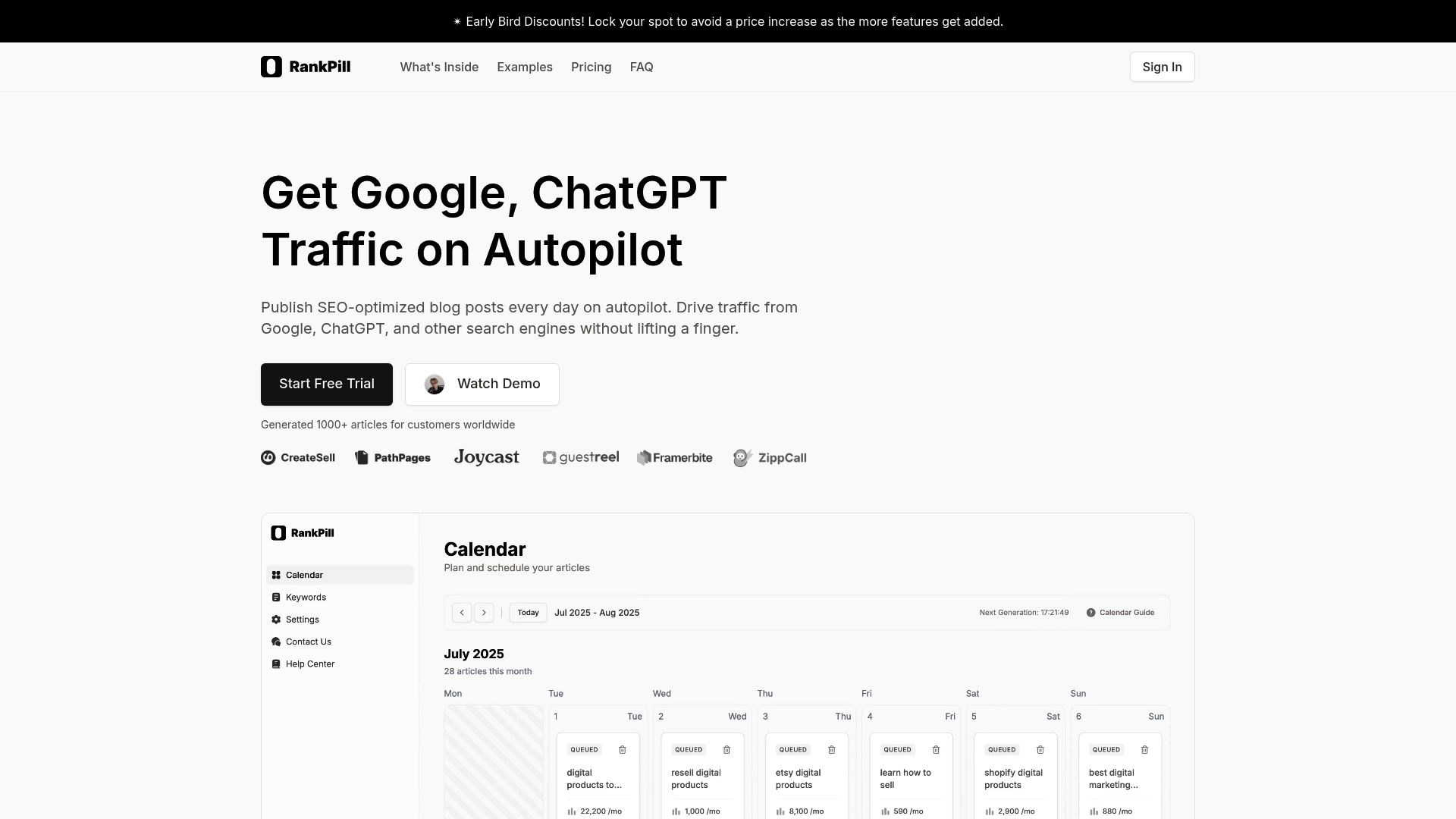In 2025, the SEO landscape is evolving faster than ever, making keyword research competitor analysis a mission-critical process for anyone aiming to dominate search results. Competition is fierce, algorithms are smarter, and the difference between ranking and being invisible often comes down to your strategy.
This guide arms you with a step-by-step blueprint to master keyword research competitor analysis using the latest techniques and tools. Whether you’re new to SEO or a seasoned pro, you’ll discover actionable methods for uncovering high-value keywords, analyzing what works for your rivals, and building a data-driven plan for growth.
Ready to outperform your competition? Dive in to learn the foundations, advanced tactics, and AI-powered strategies you need to win in 2025.
Understanding Keyword Research in 2025
Keyword research competitor analysis is entering a new era. The way we approach keyword discovery and analyze competition has changed rapidly—especially as AI and search behaviors evolve. If you want to outperform rivals in 2025, understanding these shifts is essential.

The Evolution of Keyword Research
In recent years, keyword research competitor analysis has shifted dramatically. AI-driven algorithms, voice search, and Google’s ongoing updates have made search engines smarter than ever. Gone are the days when stuffing exact-match keywords could boost your rankings.
Today, the focus is on semantic search and user intent. Google now understands the context behind queries and rewards content that answers real questions. For example, instead of targeting just “best laptops,” successful sites build topic clusters around related concepts like “laptop reviews,” “top laptops for students,” and “how to choose a laptop.”
Industry data shows that 60% of searches now use natural language. This means optimizing for how people actually speak and type—rather than just short, rigid phrases. The bottom line? Traditional keyword research competitor analysis methods alone won’t cut it in 2025.
Types of Keywords and Their Strategic Value
Not all keywords are created equal. Understanding the different types—and when to use them—can make or break your SEO strategy.
- Short-tail keywords: Broad, high-volume phrases like “running shoes.” Great for visibility, but highly competitive.
- Long-tail keywords: More specific, lower-volume queries such as “best waterproof running shoes for men.” These drive targeted traffic and are easier to rank for.
- LSI (Latent Semantic Indexing) keywords: Related terms that help search engines understand context.
- Branded keywords: Phrases that include your brand name or product.
Smart e-commerce sites often use long-tail keywords to outmaneuver giants. In fact, long-tail keywords account for 70% of organic traffic across most industries. Diversifying your approach is essential for sustainable keyword research competitor analysis success.
Tools and Metrics for Modern Keyword Research
Choosing the right tools is critical for effective keyword research competitor analysis. Leading platforms like SEMrush, Ahrefs, and Google Keyword Planner offer deep insights into search volume, keyword difficulty, CPC, and trends.
For example, Google Trends can help you spot seasonal spikes and emerging topics before your competitors do. Combining tools gives you a well-rounded view—no single platform provides the full picture.
Curious about advanced tactics? Dive into advanced keyword research methods to discover expert strategies that go beyond the basics and help you unlock unique keyword opportunities.
A quick comparison table:
| Metric | Why It Matters |
|---|---|
| Search Volume | Measures potential audience size |
| Keyword Difficulty | Assesses ranking challenges |
| CPC | Reveals commercial value |
| Trend Analysis | Identifies rising or falling interest |
Mapping User Intent to Keywords
Successful keyword research competitor analysis is all about matching your content to user intent. There are four main types of search intent:
- Informational: Seeking answers (“how to clean sneakers”)
- Navigational: Looking for a specific site (“Nike running shoes”)
- Transactional: Ready to buy (“buy running shoes online”)
- Commercial: Comparing options (“best running shoes 2025”)
By analyzing intent, you can tailor content to meet the needs of your audience. For example, someone searching “buy running shoes” is much closer to making a purchase than someone searching “best running shoes 2025.” Aligning your content with the right intent increases conversions and sets your keyword research competitor analysis apart.
Common Pitfalls and Mistakes in 2025
Even seasoned pros make mistakes with keyword research competitor analysis. Some of the most common pitfalls include:
- Relying on outdated keyword lists
- Ignoring search intent and context
- Failing to adapt after algorithm updates
For instance, many sites saw traffic drop after Google’s Helpful Content Update because they didn’t update their strategies. The key? Continuously monitor performance and refine your keyword approach as the landscape changes.
Staying agile and data-driven will keep your SEO efforts ahead of the curve in 2025.
Competitor Analysis: Foundations and Frameworks
In the fast-paced world of SEO, understanding your competition is no longer optional—it's a necessity. A robust keyword research competitor analysis is the secret weapon for identifying gaps, seizing new opportunities, and future-proofing your SEO strategy for 2025.

Why Competitor Analysis is Essential in 2025
Competitor analysis has become a cornerstone of keyword research competitor analysis. With Google's algorithms evolving and AI tools on the rise, staying ahead means tracking what others in your space are doing.
Regular audits reveal untapped keywords, highlight content gaps, and show where your competitors are winning. In fact, industry surveys show that 80% of top-ranking websites conduct competitor audits at least quarterly. For example, spotting a rival tapping into a trending keyword before you even notice it can make the difference between leading or lagging in the SERPs.
Identifying Your True SEO Competitors
Not all competitors are created equal. In keyword research competitor analysis, it's crucial to distinguish between business competitors and SEO competitors. Sometimes, a niche blog outranks established brands for your target keywords.
To pinpoint your real SEO rivals:
- Use tools like Ahrefs, Moz, and SEMrush.
- Analyze SERPs for your target keywords.
- Check industry directories for emerging players.
For instance, you might find that a small blog consistently outranks you for high-intent keywords. Identifying these competitors ensures your analysis is focused and actionable.
Key Metrics to Analyze Competitor Performance
Effective keyword research competitor analysis goes beyond surface-level checks. You'll want to assess:
| Metric | Why It Matters |
|---|---|
| Domain Authority | Measures site strength |
| Backlink Profile | Reveals trust and reach |
| Content Depth | Indicates topical authority |
| Keyword Overlap | Shows shared ranking potential |
| Content Freshness | Highlights update frequency |
Comparing these metrics helps you understand why competitors rank where they do. For example, a rival with a robust backlink profile and regularly updated content may explain their higher organic visibility.
Analyzing Competitor Keyword Strategies
A winning keyword research competitor analysis requires digging into your rivals' keyword playbooks. Extract their top-ranking keywords, spot content gaps, and identify high-value terms they're targeting.
To streamline this process, tools like SEMrush or Ahrefs can reveal which organic keywords drive the most traffic to competitor sites. For a step-by-step approach on how to extract these insights, check out this Competitor keyword extraction guide.
Reverse-engineering competitor content strategies often uncovers terms and topics you may have missed, giving you a blueprint for your next moves.
Benchmarking and Setting Actionable Goals
Once you’ve gathered your data, benchmarking is the next step in your keyword research competitor analysis. Compare your rankings, traffic, and content output with those of your top competitors.
Set realistic, data-driven goals:
- Aim for a specific increase in organic traffic (e.g., 20% in six months).
- Plan to close content gaps based on competitor strengths.
- Prioritize improvements based on what’s working in your competitive set.
Remember, actionable benchmarks ensure your SEO efforts are both strategic and measurable—key to sustainable growth.
Step-by-Step Guide: Conducting Keyword Research Competitor Analysis
In today’s ever-shifting SEO landscape, a structured approach to keyword research competitor analysis can set your brand apart. This step-by-step guide breaks down the process into actionable tasks, ensuring you leave no stone unturned when building your SEO strategy for 2025.

Step 1: Gathering a Comprehensive Competitor List
The first step in keyword research competitor analysis is compiling a list of both direct and indirect SEO competitors. Begin by searching your primary keywords in Google and noting the top-ranking domains—these are your immediate rivals.
Don’t stop at traditional competitors. Explore industry directories, forums, and tools like SEMrush or Ahrefs to uncover emerging players who may target similar audiences. In 2025, new niche competitors can spring up overnight, so keep your list dynamic and updated.
A well-curated list ensures your keyword research competitor analysis covers all relevant threats and opportunities in your space.
Step 2: Collecting and Analyzing Competitor Keyword Data
Once you have your competitor list, export their keyword data using SEO tools. Look for overlaps—keywords you and your rivals both target—as well as unique keywords where they outperform you.
Create a table to compare the data:
| Metric | Your Site | Competitor A | Competitor B |
|---|---|---|---|
| Total Keywords | 500 | 800 | 650 |
| Shared Keywords | 200 | 350 | 300 |
| Unique Opportunities | 120 | 180 | 160 |
This side-by-side view helps you focus your keyword research competitor analysis on gaps you can close and areas where you can leapfrog competitors.
Step 3: Evaluating Content Strategies and Gaps
Effective keyword research competitor analysis involves more than just keywords—it’s about understanding content. Review the types of content your competitors produce: blogs, videos, infographics, and guides.
Ask yourself:
- Are they missing in-depth tutorials?
- Do they lack video content?
- Which topics are underserved?
Spotting these gaps lets you position your content to fill unmet needs, giving you a competitive edge and making your keyword research competitor analysis more actionable.
Step 4: Assessing Backlink and Authority Signals
A powerful keyword research competitor analysis includes evaluating backlink profiles for each rival. Use tools to check the quantity and quality of their backlinks, domain authority, and linking domains.
Look for patterns: Are competitors getting links from industry blogs or leveraging guest posting? If you want to dive deeper into effective tactics, check out Building high-quality backlinks for actionable strategies.
By benchmarking your backlink profile against competitors, you’ll identify partnership opportunities and authority gaps to close.
Step 5: Mapping Keywords to Your Content Funnel
Organize your findings from keyword research competitor analysis by mapping keywords to each stage of your marketing funnel: awareness, consideration, and decision.
For example:
- “How to choose running shoes” → Awareness (blog post)
- “Best running shoes 2025” → Consideration (comparison page)
- “Buy running shoes online” → Decision (product page)
Aligning keywords with user intent at every funnel stage ensures your content resonates and converts, maximizing the impact of your keyword research competitor analysis.
Step 6: Prioritizing and Validating Keyword Opportunities
Next, prioritize keyword opportunities by filtering for search volume, difficulty, and intent. Use trend analysis to validate each keyword’s potential—seasonal spikes or rising topics can mean quick wins.
Start with low-difficulty, high-intent keywords for faster results, and gradually build toward more competitive terms. This strategic focus is at the heart of successful keyword research competitor analysis.
Step 7: Creating an Actionable Content Plan
Transform your keyword research competitor analysis into a practical publishing calendar. Schedule pillar articles, supporting posts, and multimedia content to cover topic clusters and fill competitive gaps.
Consistency is key—plan regular updates and align your topics with both user needs and trending search queries. A well-structured calendar keeps your team accountable and leverages your keyword research competitor analysis for long-term growth.
Step 8: Tracking, Measuring, and Iterating
Set up robust tracking for keyword rankings, organic traffic, and conversions. Use tools to monitor competitor changes and adjust your strategy monthly.
Keep a close eye on algorithm updates and shifting trends. Your keyword research competitor analysis should be an ongoing process, guiding you to adapt, optimize, and stay ahead in the SEO race.
Leveraging AI and Automation for Keyword Research & Competitor Analysis
Artificial intelligence is rewriting the rules of keyword research competitor analysis. In 2025, AI-powered tools can process vast datasets, spot patterns, and generate actionable insights at speeds no human can match. Businesses now rely on machine learning to uncover trends, predict search intent, and outmaneuver rivals.
The Rise of AI in SEO Analysis
AI has become the backbone of modern keyword research competitor analysis. Advanced algorithms scan millions of search queries, competitor sites, and backlink profiles in minutes. These tools can identify not just what keywords are trending, but why—revealing the intent and context behind search behavior.
For example, AI can surface untapped long-tail keywords and anticipate shifts in user queries before they go mainstream. According to industry surveys, 65% of enterprise SEOs now integrate AI into their workflows. If you want to explore more about how AI is reshaping this field, check out Using AI for SEO research.
Benefits of Automation for Businesses
Automation delivers major advantages in keyword research competitor analysis. Tasks that once took hours—like tracking rankings, exporting competitor keyword lists, or updating content calendars—are now completed in minutes. This frees up time for strategy and creative work.
Businesses also benefit from real-time data and fewer manual errors. Automated alerts can notify you of competitor moves or ranking shifts instantly. By leveraging automation, teams can focus on high-impact actions rather than repetitive tasks, making every element of keyword research competitor analysis more efficient.
How RankPill Streamlines Keyword and Competitor Analysis
RankPill is a game-changer for keyword research competitor analysis in 2025. Its AI-driven platform delivers personalized keyword lists based on your top rivals, making it easy to spot opportunities and threats. The tool automates content calendars, suggesting article topics and publishing schedules tailored to your niche.

RankPill integrates seamlessly with major CMS platforms, so you can turn insights into published content faster than ever. Compared to traditional agencies, RankPill offers a free trial and transparent pricing—empowering businesses of any size to access enterprise-grade keyword research competitor analysis. For a deeper dive into the technology, see their Using AI for SEO research resource.
Limitations and Considerations of AI Tools
Despite the promise, AI tools for keyword research competitor analysis aren’t flawless. They can misinterpret nuanced topics or miss context-specific opportunities that only a human expert would catch. Over-reliance on automation may lead to generic strategies that lack competitive edge.
Human oversight is crucial. Strategic thinking, industry knowledge, and creative content planning remain vital. Always validate AI-generated keyword research competitor analysis insights before deploying them. This balance ensures you harness the power of AI without sacrificing relevance or authenticity.
Future Trends: AI, Automation, and the SEO Landscape
Looking ahead, keyword research competitor analysis will become even more dynamic. Expect AI tools to integrate voice and visual search, analyze multi-modal data, and deliver real-time competitive intelligence. Early adopters will gain a distinct advantage as these technologies mature.
For those eager to stay ahead, exploring the Top Competitor Analysis Tools 2025 can help you understand which platforms are leading the way. The future belongs to those willing to innovate—making AI-driven keyword research competitor analysis the cornerstone of SEO success.
Advanced Tactics and Pro Tips for 2025
Mastering keyword research competitor analysis in 2025 means moving beyond the basics. To truly outperform, you’ll need to spot hidden opportunities, build deep topical authority, and adapt to the ever-shifting SEO landscape. Here’s how to take your strategy to the next level.
Exploiting Content Gaps and Quick Wins
Finding and capitalizing on content gaps is a cornerstone of keyword research competitor analysis. Start by identifying topics or keywords your competitors haven’t fully covered. Tools like content gap analysis in SEMrush or Ahrefs can reveal these hidden gems.
- Look for low-competition, high-intent keywords.
- Target under-served questions or trending topics.
- Monitor forums and social platforms for emerging needs.
For example, ranking early for a term like “2025 SEO checklist” can drive targeted traffic before larger brands catch on. Regularly updating your keyword research competitor analysis ensures you’re always ahead of the curve with fresh opportunities.
Building Authority Through Topical Clusters
Topical clusters have become critical for SEO success. This approach organizes your site into pillar pages and related subtopics, signaling expertise to search engines and users.
Here’s a simple topical cluster structure:
| Pillar Topic | Supporting Articles |
|---|---|
| Keyword Research | Long-tail keywords, LSI keywords, tools |
| Competitor Analysis | Backlink audits, SERP tracking, gaps |
By applying keyword research competitor analysis, you’ll uncover which clusters your competitors dominate—and where they fall short. Consistent, interconnected content not only boosts rankings but also increases organic traffic by up to 40%, as shown in recent industry studies.
Leveraging SERP Features and Rich Results
In 2025, capturing SERP features like featured snippets, People Also Ask, and video carousels is essential for visibility. Optimize your content structure using lists, tables, and concise answers. For instance, use:
- What is keyword research competitor analysis?
- How do I find content gaps in 2025?
Targeting “best tools for competitor analysis” can land you in a snippet, driving more traffic than traditional rankings. Remember, 54% of clicks now go to the first SERP feature, making this tactic a must in your keyword research competitor analysis strategy.
Monitoring Competitor Movements in Real-Time
SEO isn’t static—your rivals are constantly evolving. Set up real-time alerts with tools like Mention or SEMrush Alerts to track when competitors publish new content or climb in rankings.
React quickly when you spot a competitor launching a new guide or acquiring a powerful backlink. Swift response, driven by continuous keyword research competitor analysis, lets you reclaim lost ground or leapfrog ahead in the SERPs.
Integrating User Experience and Technical SEO
A seamless user experience and robust technical SEO are now inseparable from keyword research competitor analysis. Analyze why competitors might outrank you—often, it’s due to faster site speed, better mobile usability, or superior Core Web Vitals.
Platforms with advanced features, such as Ahrefs' Advanced SEO Capabilities, make it easier to benchmark these technical factors. Combining user-focused improvements with ongoing keyword research competitor analysis ensures your content not only ranks, but converts.
Continuous Learning and Adaptation
The SEO landscape is always shifting. Stay ahead by engaging with SEO communities, reading case studies, and participating in forums. Regularly revisit your keyword research competitor analysis to adapt to algorithm updates and new industry trends.
AI is playing a bigger role than ever—resources like AI's Impact on Keyword Research can help you leverage the latest tools for smarter decisions. Ultimately, agility and a commitment to learning are your greatest assets in 2025.
We've covered a lot about mastering keyword research and competitor analysis for 2025, from understanding search intent to leveraging the latest AI-powered tools. If you’re ready to make your SEO strategy more efficient, cut through the noise, and actually see results—now’s the perfect time to take the next step. With a platform like RankPill, you can automate keyword discovery, analyze your competition in depth, and plan out your content—all with less effort and more impact. Why not put these insights into action and see how much easier SEO can be? Get Started